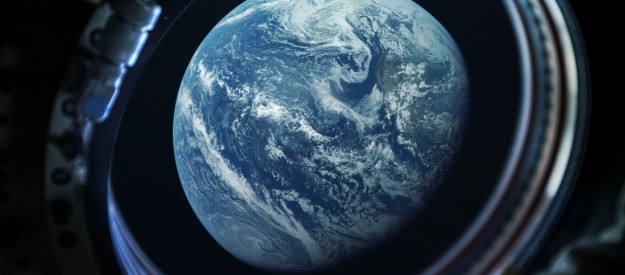"We are losing our attitude of wonder, of contemplation, of listening to creation and thus we no longer manage to interpret within it what Benedict XVI calls 'the rhythm of the love-story between God and man.'"
+ Pope Francis
Four things every Catholic should know about climate change

An international push by the Global Catholic Climate Movement to mobilize Catholics for the secular Peoples Climate March is just one indicator of the growing involvement in climate advocacy of the Roman Catholic Church. Here in the States, the Catholic Climate Covenant is also leading the charge at a time when the Trump administration is threatening environmental protections and debating what to do with the Paris climate accord.
It’s certainly a busy time for Catholic climate advocates. It can also be a little confusing for those who may not know what to think of all this—or who are hearing worrisome reports about the Church’s eco-efforts.
And so here’s a primer on four things that should help Catholics see why so many of their brothers and sisters are worried, why they’re so active in climate advocacy, and why they’ll be marching (or praying, or both) for a better future this Saturday and beyond.
1. We know a lot
We know that gases like carbon dioxide are supposed to be in the atmosphere—and we’re glad that they are. They help keep the planet warm enough for life. They do so by trapping just the right amount of the sun’s heat. But add more gases like carbon dioxide, and you retain more heat—just like what happens by adding more glass in greenhouse, more blankets on your bed, or another layer of clothing on a biting winter’s day.
We know that carbon dioxide levels have fluctuated over time. That’s normal. And as they fluctuate for natural reasons, the world’s temperatures have also fluctuated—up and down as natural levels of carbon dioxide go up and down.
We also know that these levels are at the highest they’ve been in some 800,000 years. Right now there is over 400 parts of carbon dioxide in every million parts of the atmosphere. But for almost 800,000 years, that number has only gotten as high as around 300 parts per million, and often much less. That's a big jump.
We also know that this spike has taken place pretty quickly in those 800,000 years. It’s been only over the past one hundred years or so that that we’ve gone from a maximum of 300 or so parts per million to 400—up and down throughout every year as the seasons come and go, but with an upward trend that cannot be denied.
Check out the video below that shows all this. It's about three and a half minutes long. It starts with a look at increasing carbon dioxide levels for the past few decades, then goes back in time 800,000 years:
Two more points: We know where this excess carbon dioxide is coming from the burning of fuels like gas, oil, and coal—which all emit carbon dioxide when they go up in flames.
And finally, we know that with carbon dioxide levels up this high, by a third over the highest levels seen these past million years—which, by the way, means within the lifespan of humanity thus far—the resulting increases in thermal energy in our oceans and air will become noticeable. And in fact, it has.
2. We’re experiencing the change already
Here in my corner of the Northeast United States, sea levels are up about a foot in the last century. Here's the data for Newport, Rhode Island. As a result, that city is experience urban flooding in areas and with frequencies that they haven’t before. At certain high tides, storm drains are flowing backward and neighborhoods are threatened.
Rainfall intensities in my region are increasing, too—not the number of storms, but how much water vapor they bring with them. So much so that in 2010, colleagues in my office had to update our stormwater design guidance to factor in the new intensities of rainfall. And just last month we issued a report on the impacts of all this on our state’s wastewater infrastructure.
Around the world, farmers and the fishing industry are seeing changes in growing seasons and changes in fishery habitats—all thanks to periods of warmer weather and a measurable increase in sea temperatures.
Areas in the Pacific are seeing stronger typhoons as other areas of the globe are experiencing severe droughts.
All this, and more, is what the laws of nature tell us will happen when you increase the atmospheric levels of heat-trapping gases like carbon dioxide.
Of course, it should go without saying that droughts, stronger storms, and changes to agricultural growing patterns and fishery stock all have impacts on people, communities, nations, and the ecosystems that nurture life. This adds levels of moral dimensions to the science of climate change.
3. Businesses and governments are concerned
I wasn’t always concerned about changes to climate. Then about ten years ago I heard a talk by an engineer with the big insurance company FM Global. Turns out they were doing their own checking on climate change, running their own numbers on what it could mean to their bottom line. The engineer put on a captivating data display that justified why they—a conservative, private company—were worried, and why they were taking steps to plan for higher insurance claims from a changing, warmer climate.
More recently, hundreds of companies here in the United States have been urging President Trump to remain in the Paris climate agreement, forged almost two years ago. The companies—like Schneider Electric, Nike, General Mills, Hewlett Packard, and Hilton—are already planning for a profitable business plan in a world fueled by renewable-energy. Breaking the Paris Accord, they say, would only hurt American competitiveness.
In short, the new economy is a renewable economy. Savvy business leaders know this.
And it turns out, so do military leaders.
4. For Catholics, climate change advocacy is not about politics
Many of my Catholic brothers and sisters worry over the Church’s involvement in climate advocacy. They fear that the Church is being duped by global leftist advocates of abortion, artificial contraception, and other modern realities spawned in a culture of death.
After all, some political and social activists are always looking for entry points to challenge Church teachings. But solutions to eco-issues that are rooted in death are not consistent with the Catholic view of tackling eco issues. This has been the clear message of Saint John Paul II, Benedict XVI, and Pope Francis.
The Church enters the eco and climate issues armed with Christ’s Gospel and his life-giving grace—and the full array of Church teachings to teach and defend. We enter the world of climate advocacy to baptize it, and so make it an authentic battle for life.
We do this aware that the battle for a cleaner world is not a political battle. It is a spiritual one. And we are not afraid to fight on that front.
And so …
Given what we know, and what we’re seeing, and what others are doing, you and I have the responsibility to be part of the eco-issues of our age, because we have the responsibility to bring the Gospel to a world threatened with darkness. With our Catholic DNA of faith and reason, held together with charity and truth, we are bound by the love of Christ to nurture a more virtuous world that embraces sacrifice, temperance, and justice.
In the matter of climate and eco-advocacy, some of us will march; some pray; some teach; some help the needy; some will do all of the above, and some only what they can. But in the end, we must all do something to leave the generations to come a planet as rich, healthy, and stable as the one God gave to us to care for.


















